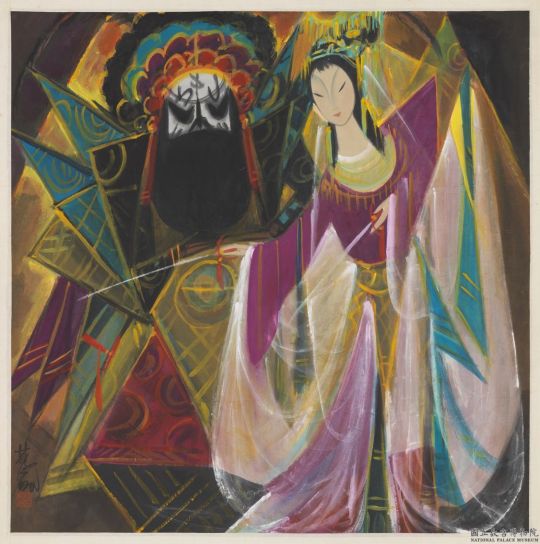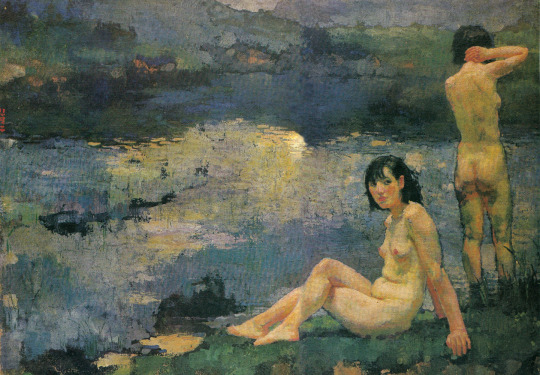reflections of an art history student. focus on female artists and depictions of women in modern chinese and taiwanese art of the early 20th century, . based in taipei, taiwan.
Don't wanna be here? Send us removal request.
Photo

Seated Lady on an Armchair. Sanyu (常玉). Watercolor on paper. 1920-30.
Sanyu (1896-1966) was a Chinese painter who lived in Paris during the heyday of the Montparnasse crowd, running in the same circles as artists such as Pablo Picasso and Henri Matisse. Born in Sichuan province when the Qing dynasty still ruled China, Sanyu witnessed rapid changes throughout his life. After the May Fourth Incident in 1919, he and fellow artists including Xu Beihong travelled to Europe to study Western painting. Sanyu settled in Paris in 1923 where, supported financially by his brother who worked in the silk trade, he produced thousands of nude studies in ink and, later, oil paintings that straddle the Chinese and Western traditions. Free-flowing, energetic, and infused with modernist attitudes, Sanyu’s studies of the female body remain fascinating to this day.
Follow sinθ magazine for more daily posts about Sino arts and culture.
64 notes
·
View notes
Photo

Lee Yi-Nin (Li Qi’nian, 李綺年) on the cover of Liangyou (良友) in 1937.
This Hong Kong-born film star rose to fame in the mid-1930s and was dubbed the “Southern Screen Goddess (南國影後),” starring in such films as Lifeline 生命鏡 (1935), The Sun Rises Again 重見天日 (1937) and The Luminescent Cup 夜光杯 (1939). Sadly, almost all of her films have since been lost and Lee’s story has largely been forgotten.
3 notes
·
View notes
Photo

徐悲鴻,《女人裸》(1924),目前由北京徐悲鴻紀念館典藏。
Xu Beihong (1895-1953), Female Nude (1924), Xu Beihong Memorial Museum.
#1920s#Shanghai#Chinese art#women in art#life drawing#modern art#art revolution#modernist#republican era#female beauty
7 notes
·
View notes
Photo

林風眠,《紅顏將軍》,目前由台北故宮博物院典藏。 Lin Fengmian, Beauty and a General, National Palace Museum collection.
Currently on show at She & Her: On Women and Their Art in Chinese History 「她—女性形象與才藝」until 27th Dec.
#lin fengmian#Chinese art#modern art#cubism#picasso#national palace museum#taipei#Beijing opera#Chinese opera#dynamism#abstraction#female beauty
7 notes
·
View notes
Photo

李梅樹,《小憩之女》(1935),目前由李梅樹紀念館典藏。 Li Mei-shu, Resting Lady (1935), Li Mei-shu Memorial Gallery.
2 notes
·
View notes
Photo

徐悲鴻 《湖畔 》(1935) Xu Beihong, Lakeside (1935), from Paintings of Xu Beihong (1988)
Art critic John Berger (1926-2017) discusses the “male gaze” at length in his programme, Ways of Seeing (1972). Although he speaks in reference to Western works, his theories can be easily applied to the works coming out of Shanghai in the 1920s and 1930s. Berger states that “to be naked is to be oneself”, however, “a woman [when nude] is a sight to be looked at,” and “to be nude is to be seen naked by others and yet not recognised for oneself. The nude has to be seen as an object in order to be nude.”
This can be seen in Xu Beihong’s oil painting, Lakeside (1935), two nude women relaxing and bathing by the side of a lake. The figure on the far right is standing facing away from the artists, whilst the seated figure stares directly at the viewer, and there is a sense that they have been disturbed. The painting is visibly very similar to Manet’s Luncheon on the Grass to which Berger references in Ways of Seeing. Unlike Luncheon, there are no clothed male figures painted in Xu’s painting, yet a male presence is certainly felt.
#Xu Beihong#徐悲鴻#luncheon on the grass#manet#modern art#art history#shanghai#1930s#oil painting#Chinese art#John berger#ways of seeing
33 notes
·
View notes
Photo

郭雪湖 〈南街殷賑〉(1930),目前由台北市立美術館典藏。 Kuo Hsueh-hu, Parade on South Street (1930), Taipei Fine Arts Museum.
25 notes
·
View notes